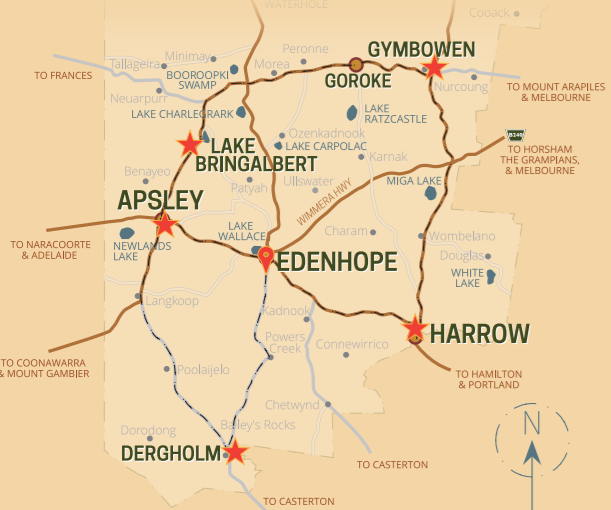Aboriginal Cricket Trail
Historical Cricket Trail
Starting at the cairn beside Lake Wallace in the grounds of Edenhope P-12 College in Lake Street, this trail will take you on a journey discovering the story of the first Australian cricket team to tour England in 1868.

Lake Wallace, Edenhope
Visit the training ground for Australia’s first international touring cricket team. A mural depicting the team along with a Cairn and information bay are open for public viewing year-round.
Dergholm
Visit the commemorative stone located on the banks of the Glenelg River, River View Road, Dergholm for team member Brimbunyah (Tommy Red Cap).
Aspley
There is a commemorative stone located at Apsley cemetery gates for team member Murrumgunerrimin (Jimmy Tarpot).
Bringalbert Station (Lake Bringalbert)
Visit the Site of the first original cricket match between Aboriginal and European station hands. Visit the commemorative pannels along the lakes edge that tells the story of Tom Hamilton and team member Unamurrimin (Jellico).
Jane Duff Memorial, Gymbowen
In 1864, Jane Duff and her two brothers went missing in the bush. As well as the selfless actions of Jane, this memorial commemorates the joint effort of Aboriginal trackers and early settlers to find the children. There is a memorial stone for team member Djungadjinganook (Dick-a-Dick).
Harrow
Visit the Harrow Discovery Centre which tells the story and houses a considerable range of artefacts. Every year on the Victorian March Labour Day long weekend, a team of Indigenous cricketers and a team drawn from the local cricket association, come together at Harrow for the honour of winning the Johnny Mullagh Memorial Cup. Visit the Harrow Cemetery where team member Unaarrimin (Johnny Mullagh) is buried. There is a headstone to mark his grave.
West Wimmera Cricket History
Of all the remarkable sporting stories to come out of the country, perhaps none are greater than West Wimmera’s. Not only is this home to Australia’s first international cricket team, but the nation’s first sporting team of any code to compete abroad.
Their 1868 tour to England itself was one of great success. The team was made up from West Wimmera’s sheep stations (who used the grassy banks of Lake Wallace in Edenhope as their training ground), and despite being newcomers to the game, these cricketing trailblazers were able to match it with the English on their home turf. On what was a gruelling tour of 47 matches, they earned great respect – on and off the field –levelling the series with 14 wins apiece and 19 draws.
There was no greater player than local legend, Johnny Mullagh (Unamurrimin). Dominating with bat and ball, only in recent years have his achievements been formally recognised: both inaugurated into the Australian Cricket Hall of Fame in 2020; and having the Boxing Day Test man of the match medal awarded in his honour.
But this is a story that transcends cricket. Beyond the dazzling sporting feats, it’s one shrouded in controversy and tragedy, and sheds light on Indigenous Australians shameful treatment as second-class citizens.
To learn more of their story, head to the Harrow Discovery Centre, a brilliantly curated museum dedicated in honour of West Wimmera’s cricketing heroes. It also features a priceless collection of Sir Donald Bradman items. But this is a chapter in history the entire West Wimmera is proud to promote, and you’ll find commemorative markers across the shire celebrating their efforts.